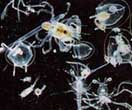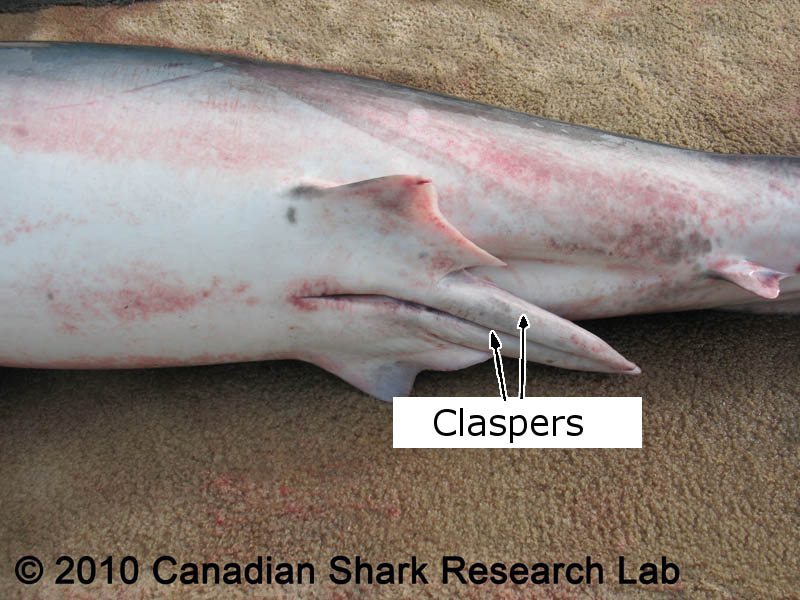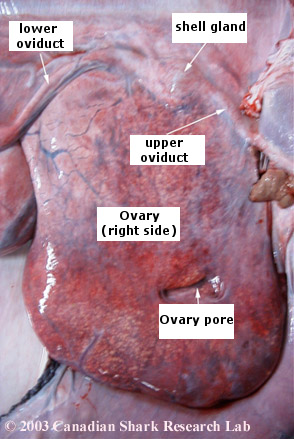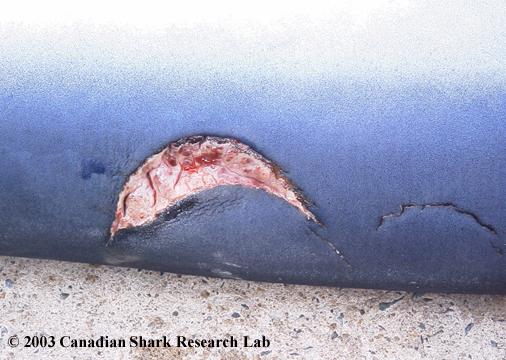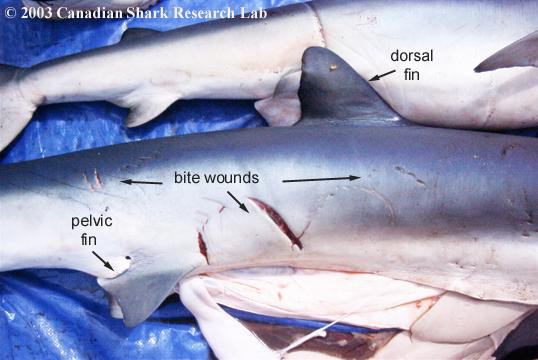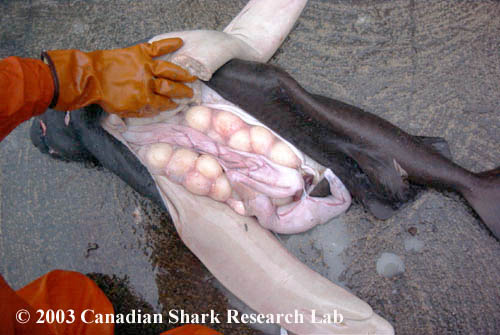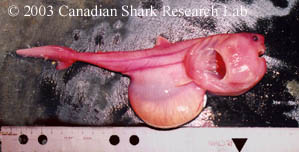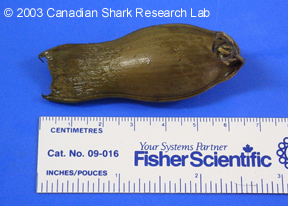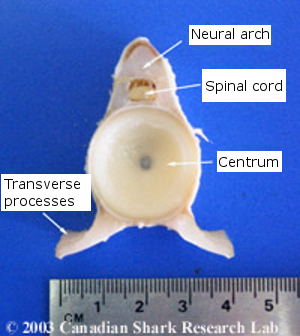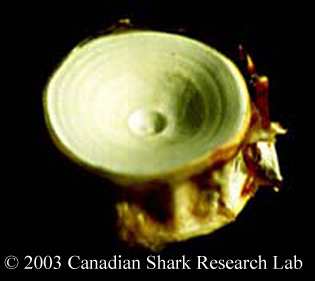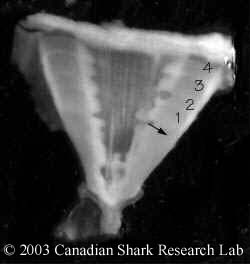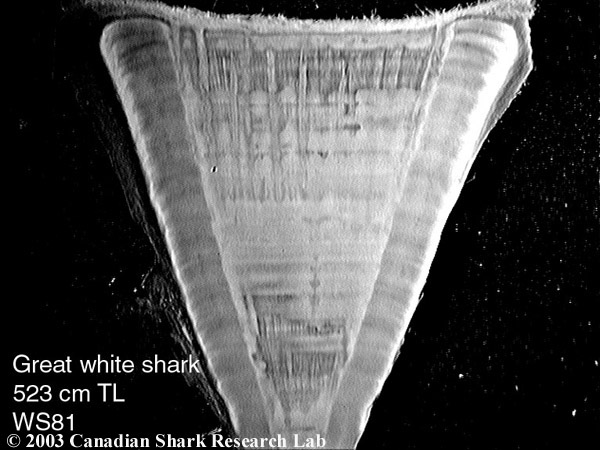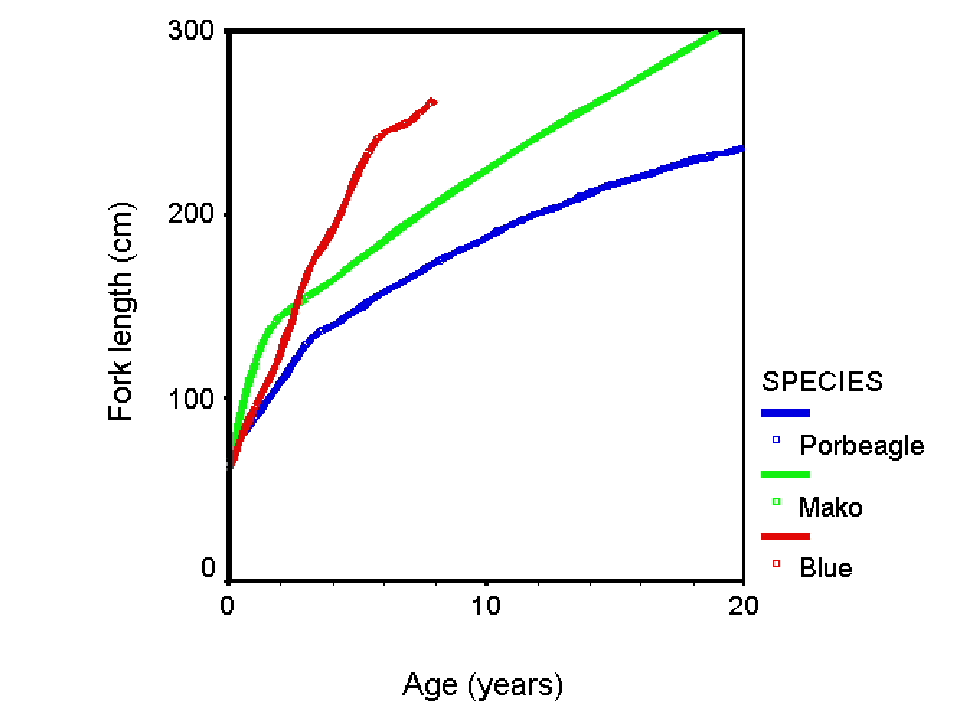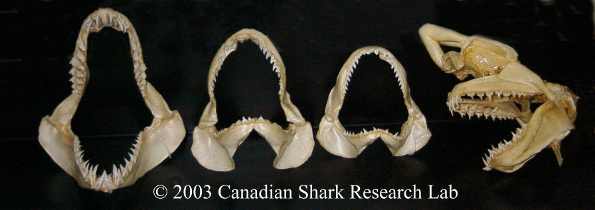Interesting facts
Feeding habits
The feeding habits of sharks are varied and are based on the four main diet types: fish, mammals, crustaceans and plankton. The diet of a shark determines many aspects of its life including where it lives, the time of day that it is active, the depths at which it can be found, and the type of teeth and jaw that it possesses.
Sharks that eat fish are usually pelagic, ranging throughout the water column. Examples in Canadian waters include porbeagle, mako and blue sharks. Their teeth tend to be narrow and sharp in order to grasp their prey while swimming. This picture shows the stomach contents of a fish-eating porbeagle shark. Visible in the photo are the partially digested remains of lancetfish, squid and haddock (mouse over to view the image at its full size).
Sharks like the great white feed mainly upon marine mammals like seals or sea lions. Although their diets are not exclusive to mammals they possess teeth that are specialized for handling large animals like cetaceans. The teeth are serrated and allow them to remove large pieces of flesh.
Bottom dwelling species of shark like the deepsea cat shark eat crabs and other crustaceans with a hard outer shell. Sharks that eat crustaceans have short grinding teeth that are used to crush their food. Relatively few of the shark species in Canada are this type of feeder.
Sharks that eat plankton have specialized feeding mechanisms. The basking shark eats plankton by swimming at the surface with its mouth open. The water rushes through the mouth and out the gills. Gill rakers at the entrance to the gill catch and filter out all of the plankton (small organisms that float in the water).
Gill rakers, like the ones seen in this picture, are numerous in the basking shark, but are shed in the winter when the food supply of plankton is scarce.
Plankton, are the microscopic organisms that float in the water. They are often clear or translucent like the ones seen in this photo. It takes large amounts of these small organisms to support a shark as large as a basking shark.
Reproduction
Sharks are sexually dimorphic. That is, there are visual differences between males and females. Males, like the one seen in this picture, have pelvic claspers which are modified pelvic fins used for sperm delivery.
Claspers are rolls of cartilage that become stiffened with calcium in the adult. The presence or absence of these claspers make it very easy to differentiate males from females. Males also have paired testes, however the right one is always more developed than the left, which may be smaller or absent altogether.
The testes are internal and are located in the anterior end of the body cavity within the epigonal organ. The urinary and reproductive tracts join together to form the urogenital sinus. From there the sperm is eventually released into the groove of the claspers and is then delivered to the female during copulation.
Females do not have claspers. Instead they have a cloacal opening (as do the males) between the pelvic fins. The internal ovaries are found anteriorly in the body cavity and are paired, but as was the case with the male testes the left side is often reduced. Indeed, the left ovary often releases very few or no eggs.
Compare the reproductive organs of mature female blue and porbeagle sharks (Note: these are high resolution images, so images will take somewhat longer to display). Click here for internal images of the spiny dogfish.
Once eggs are released and fertilized, a horny shell or membrane is secreted around each one as they pass through the oviducal gland or shell gland. Some sharks produce a shell that is tough and can protect the young. In other species the membrane is slight or vestigial and the young develop and hatch within the uterus of the female. The eggs and egg cases produced by different species are highly variable. Eggs can be up to 60 or 70 mm in diameter and encased in shells up to 300 mm long. Shapes vary from spindle to purse-like with tendrils and hooks.
During copulation sharks meet face to face. As seen in this picture the male inserts one of his claspers into the cloaca of the female. Sperm contained within sperm packets called spermatophores are delivered to the female via a groove in the clasper. The spermatophores are forcefully ejected by contracting organs known as siphon sacs which use seawater currents to carry the spermatophores
Another marked difference between the male and female sharks of some species is the thickness of their skin. The skin on a female blue shark is nearly twice as thick as that of males. It is believed that this is because of the viciousness of mating. Males will often bite females during face to face copulation leaving them with wounds. Without the extra thickness of the skin females could be severely injured.
Click on the thumbnails below to see bite marks on the left pectoral fin of a female porbeagle (left) and on female blue sharks (center, right).
Mating behaviour in sharks can be very complex and evidence suggests that there is some degree of mate selection within certain species. Sexes often segregate, and only come together to mate. Occasionally congregations form in mating behaviour. For instance, basking sharks have been seen forming mating circles like the one seen in this picture. The exact purpose of this behaviour is not known however it is clear that it related to mating.
There are three modes of reproduction within the sharks. In general most sharks bear live young, however there are some sharks who lay eggs. The most advanced form of development is called viviparity. This is when the female provides nourishment for the embryos as they develop inside of her. The nourishment can be delivered as a secretion called uterine milk or through a placental connection.

Photo modified from Eve Bunting, The Sea World Book of Sharks. 1979. Halcourt Brace Jovanovich Publishers. Orlando, Florida.
The hammerhead shown in this picture is an example of viviparous development. The placental connection to this fetus would have been connected to the uterine wall of the mother.
The most common form of development is referred to as ovoviviparity. This is similar to viviparity because the eggs are fertilized, hatch and develop within the body of the female. However the embryos do not receive any direct nourishment from the mother other than the initial investment of the egg production. In some species, the young can receive nutrients by devouring newly ovulated eggs or smaller, less developed embryos or siblings. This is known as oophagy.
Examples of ovoviviparous development (Click on the thumbnail photo to view the full size image). In this example of a portuguese shark, the developing ova can be clearly seen within the ovaries. The eggs will eventually move into the uteri where they will hatch, developing into an embryo nourished by large amounts of yolk. Further examples of various embryo stages of ovoviviparous development can be seen in the spiny dogfish and porbeagle sharks.
The final type of development is known as oviparity. In oviparous reproduction, sharks lay eggs in the form of egg cases, which they attach to algae or corals. The egg cases of at least one species are designed to be pushed into the sediment. Once the eggs are secure the female then leaves and the eggs receive no subsequent protection or nourishment.
A number of small dark eggs can be seen in the upper parts of the coral in this picture. Small tendrils attached to the egg case are used to fasten it to corals and algae. Without the protection of the mother,the embryo is then able to develop and hatch with some level of protection from predators.
Ageing sharks
The age of a shark is determined by counting the growth rings formed on the vertebra. The vertebral rings are laid down on a yearly basis not unlike those of trees. This method is analogous to the method used in ageing bony fish using the otolith (earstone), although not as well refined. However, sharks do not have otoliths, necessitating the use of the vertebrae. The web site of the Otolith Research Laboratory gives a more complete description of age determination practices in bony fish. The web site Skates and Rays of Atlantic Canada provides detailed information and methods on the age determination of skates and rays.
Vertebrae from the backbone of the shark are prepared for ageing by embedding and sectioning them. Several vertebrae from the cervical region are first removed from the animal and all the surrounding tissue (muscle, etc) cut away from the centra. The top of the haemal arch is removed to allow removal of the spinal cord. One or two of the calcified centra are then sectioned through the centre of the centrum with a low-speed diamond-bladed saw. The cut is made perpendicular to both the centrum face and the haemal arch. For shark species with large vertebrae (like whale and basking sharks), a specialized sectioning method is required; this method is demonstrated in a YouTube video on large vertebra sectioning. Generally, paired blades separated by a 0.6 mm spacer are used to prepare a thin section with one cut. The vertebra is now ready for image analysis and identification of growth rings. Variations of the above sequence may be better suited for some shark species. For example, the vertebrae may be frozen, dried, X-rayed or pre-treated with chemical dyes to enhance visibility of the growth rings.
Below are some images of vertebrae from older porbeagle, blue, mako and white sharks. Click on the images to compare the differences between these species (Note: these are high resolution images, so the images will take somewhat longer to display).
Growth curves show the average size of a shark at each age, as determined from vertebral ring counts. Preliminary growth curves for the blue shark, the shortfin mako and the porbeagle shark are shown below. Although growth curves provide a good overall indicator of size at age, factors such as the state of health, reproductive state and local conditions can all modify the growth rate of individuals. Examples of growth curves and shark age determination are shown in Campana et al. (2002), Natanson et al. (2002) and MacNeil and Campana (2003).
Estimates of age, growth rate and longevity in sharks all assume that the vertebral rings are an accurate indicator of age. While this is probably true in most cases, confirmation of their accuracy (known as age validation) is lacking for most shark species. We now have age validation based on bomb radiocarbon for several shark species: porbeagle (in both the NW Atlantic and the South Pacific), mako and spiny dogfish.
Shark attacks
The waters of the Canadian Atlantic are considered to be some of the safest waters in the world in regards to shark attacks, despite the number and variety of shark species present. The most common sharks in Canadian waters tend to be harmless, or are found offshore or in deep water. As well, cold water temperatures are present year round and relatively few people venture into the water compared to warmer climates. The result is that most sharks in Canadian waters are rarely encountered by humans, and those that are encountered tend not to be dangerous.
There are only a few species worldwide that are actually considered dangerous to humans, and none of those are regularly found in Canadian waters. The great white is considered very dangerous to people, but is extremely rare off Atlantic Canada (reported only about once every 5 years). They are often caught accidentally, usually from becoming entangled in herring weirs or cod nets. However, great whites have apparently been involved in a few unprovoked attacks on small boats in the past off Nova Scotia and in the Bay of Fundy. One such attack occurred on July 2, 1932, about 16km northwest of Digby Gut, Bay of Fundy. In the early morning on a calm day a large shark attacked a fisherman and his son in their 7.6m motor-boat while they were hauling in their fishing gear. The shark bumped the boat repeatedly, working its way aft until it was clear of the boat . When inspected later on shore, they found the propeller blades bent, scrapes in the hull and a few teeth left embedded in the hull and keel. Upon examination of one of the teeth, the shark was determined to have been a great white around 4.6m in length.
Another unprovoked attack occurred off Fourchu, Cape Breton in July of 1953. The boat was bitten and sank, dumping the two fishermen in the water. The shark did not attack the fishermen but one man drowned in his attempt to swim to shore. Again the attacking shark was identified by tooth fragments embedded in the hull. This shark was estimated to be 3.7m in length.
In the fall of 2000, a sea urchin diver encountered a shark while diving off Digby, Nova Scotia. The shark, apparently attracted by nearby lobster bait, displayed some aggressive characteristics; bumping the diver, attempting to grab his catch bag and even hauling him several feet. The diver was unharmed but the shark remained and circled him for a short time after. Judging by the description of the diver the attacking shark was probably a porbeagle shark.
In the summer of 2004, a father-son team fishing at a shark derby were admiring a blue shark which they had just caught and pulled up to the side of the boat. The boy attempted to lay his hand on the snout of the shark while it was in the water, trying to put it into a "trance" as he had seen done with great white sharks on TV. Apparently, the shark had not seen the same TV show, and it bit the boy's hand. Fortunately, only a few stitches were required. (NOTE: attempting to put your hand on the head of a live shark is NOT a good idea!).
Blue and whitetip sharks were implicated in attacks on injured people coming from torpedoed boats in the mid-Atlantic during World War II. Whitetip sharks have been known to be quite aggressive but blue sharks are not normally considered to be dangerous. Greenland and mako sharks can grow large enough to attack a person, but have never been known to do so in Canadian waters. All of the above species tend to be found in offshore waters rather than near shore. Based on reports from other countries, most shark attacks tend to be associated with spear fishermen carrying bleeding and injured fish, or in the case of the great white, proximity to a seal colony.
Demystifying shark myths
Most people think of sharks as vicious predators. This state of mind was popularized by the movies Jaws and Deep Blue Sea. However, the perception is both unfortunate and incorrect, since there are relatively few unprovoked shark attacks on humans worldwide. Of the more than 350 species of shark in the worlds oceans only a handful of them are even considered dangerous to humans. Dangerous species found in Canadian waters include the great white, mako and oceanic whitetip. Overall, the chance of being attacked by a shark is considerably less than that of being hit by lightning or of being eaten by a crocodile. Most of those attacks that do occur are in the waters off of South Africa and Australia. In Atlantic Canada, there have been four accounts of sharks attacking small boats, three of which have been attributed to the great white shark by positive identification of teeth or tooth fragments found embedded in the hull. See also Shark Sightings.
What do sharks eat?
Answer:
Most sharks are predators, although the two largest species (the basking shark and whale shark) have no obvious teeth and eat only plankton (tiny floating animals). The majority of sharks eat fish and invertebrates, while some feed upon marine mammals such as seals and sea lions. Other animals have been found in shark stomachs as well. Bones and vertebrae from cows and reindeer, chickens, dogs, penguins and other birds have all been found, as well as a number of more intriguing items: tin cans, a wristwatch, an engine block, a partial suit of armor, parts of a rocking chair, bottles, buttons, shoes, belts and a handbag. Most sharks in Atlantic Canada are too small to eat large items, but fishing line, rope, balloons, lobster bands, candy wrappers and an oil filter have been found in stomachs of the porbeagle shark.
How big can sharks grow?
Answer:
Sharks come in a range of sizes. The largest shark known is the whale shark, which reaches lengths of 12 metres (almost 40 feet) or more. The smallest shark, the dwarf shark, is only 25 cm (10 inches) long. The basking shark is the largest shark in Atlantic Canada, routinely reaching lengths of 8-9 metres. The largest confirmed great white shark caught in Canada was more than 5 metres long. It was caught off of PEI in 1983. Before this, a white shark was caught in a herring weir in the Bay of Fundy in 1930 which was reported by local fishermen as being 11 metres long. For awhile, this was considered the largest specimen ever caught, but when the jaws were compared to that of other jaw specimens, they were more similar to a shark of around 4.8 metres. The world record is 6.3m.
How long have sharks been around?
Answer:
Sharks have been around since the Upper Devonian, approximately 409 million years ago. The subclass Elasmobranchii, to which the sharks belong, have contained three branches through time. The original and most primitive branch is the cladodontoids branch, which is now extinct. The second branch is the hybodonts, who are also now extinct, but who eventually gave rise to the modern sharks and rays contained in a grouping called the elasmobranchs. There are still a few shark species alive today that represent a transitional position between the hybodonts and today's modern shark.
Do porpoises attack sharks?
Answer:
It has become close to an urban myth that dolphins and porpoises regularly attack sharks that come too close. The reality is somewhat different. In some parts of the world, dolphins are frequently preyed upon by large shark species such as whites, bull sharks and tiger sharks. In general, dolphins will avoid close encounters with predatory sharks, and ignore those not viewed as being a danger. Although there have been at least two documented occasions in which groups of dolphins have chased away threatening sharks, such occasions appear to be more the exception than the rule.
How are sharks helpful to humans?
Answer:
Sharks have many uses to humans. Nearly every part of the shark can be used: its flesh can be eaten, the skin can be used as leather, and the teeth used for jewelry and ornaments. Oil extracted from the liver has been used for high grade machine oil, vitamin A supplements and in ladies cosmetics. The fins have also been used in shark fin soup, although this practice is being discouraged, since it is contributing to overfishing of some shark species. Parts of the shark have medicinal value as well. The shark cornea has been used in eye surgery (since its cornea is similar to our own). Shark cartilage has become a popular natural source of possible anti-cancer agents, since sharks have low cancer rates. However, there is no evidence that shark cartilage actually has anti-cancer activity. But the most important aspect of sharks is their role in the marine ecosystem: as apex predators, they help control many fish and marine mammal populations, and thus help keep the ecosystem healthy.
Links
Canadian shark websites
- Otolith Research Lab
- Canadian Science Advisory Secretariat
- Canadian Pacific Shark Research
- Nova Scotia Museum of Natural History
- Shark Research Committee (Pacific Coast)
- Sharks of the Atlantic Research and Conservation Coalition (ShARCC)
- Science and Technology for Canadians
Scientific shark websites
- Alaska Shark Assessment Program
- American Elasmobranch Society
- Australian Museum Online
- Bimini Biological Field Station Shark Lab
- The Marine Biological Association Basking Shark Research
- Center for Shark Research at MML
- CSIRO White Shark Tagging Research œ Australia
- CSULB Shark Lab
- Elasmobranch Research Lab at F.A.U.
- Florida Museum of Natural History
- Fox Shark Research Foundation
- Greenland Shark and Elasmobranch Education and Research Group (GEERG)
- Moss Landing Marine Research Lab œ Pacific Shark Research Center
- Mote Marine Laboratory
- Natal Sharks Board of South Africa
- Panama City Laboratory Shark Population Assessment Group
- Tiger shark Research Program of Hawai'i
- Dr. Tim Tricas Elasmo Lab Homepage
- Utila Whale Shark Research œ Honduras
- U. Washington Shark Research Lab
Educational and conservation shark websites
- Elasmodiver
- Enchanted Learning Shark information (suitable for children)
- Fiona's Shark Mania
- Guadalupe Island Conservation Fund (great whites)
- Mediterranean Shark Site
- Pelagic Shark Research Foundation
- ReefQuest Expeditions: Shark Program
- Shark Research Institute
- South African Shark Conservancy
- Underwater Times (news and photos)
- Date modified:



